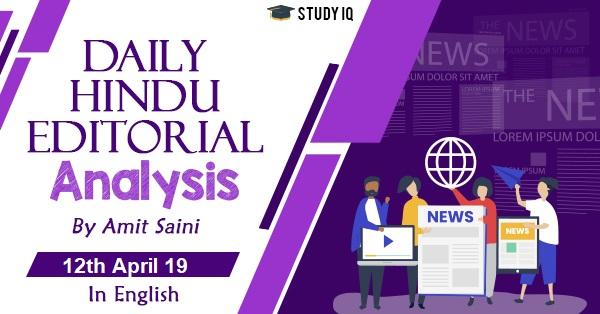Table of Contents
Reflections on a massacre
- Jallianwala Bagh’s importance lies in what preceded it and in what followed
UDAY BALAKRISHNAN
- For Indians, the massacre that evokes strong emotions is not Nader Shah’s slaughter of 30,000 people in Delhi in 1739 but Jallianwala Bagh in Amritsar, where, a century ago, on April 13, troops commanded by General Dyer fired into an unarmed crowd, killing hundreds.
- The massacre at Jallianwala Bagh, like later ones in Lidice (1942) and My Lai (1968), was relatively small. It was nothing compared to the hundreds of thousands killed by the Japanese army in Nanjing in 1937-38 or by Indonesian soldiers in East Timor 1975 onward.
- Jallianwala Bagh’s importance lies not in the numbers killed but in what preceded it and in what followed. The Anarchical and Revolutionary Crimes Act of 1919, better known as the Rowlatt Act, came into force a month before the massacre in Jallianwala Bagh.
- It shocked most Indians who had expected to be rewarded, not punished, for willingly fighting alongside the British in the First World War.
- The massacre, followed by the feting and rewarding of its perpetrator, General Dyer, by the British public, removed all illusions about benign British rule in the country. It also marked the start of a liberation struggle like no other under Mahatma Gandhi.
- It took Nobel laureate Rabindranath Tagore to capture the full import of the outrage at Jallianwala Bagh. In his letter of protest renouncing the knighthood conferred on him, he wrote:
- “The accounts of the insults and sufferings by our brothers in Punjab have trickled through the gagged silence, reaching every corner of India, and the universal agony of indignation roused in the hearts of our people has been ignored by our rulers — possibly congratulating themselves for what they imagine as salutary lessons.”
- Many massacres in history fade while some linger as grisly curiosities. The killing of every male inhabitant of the Persian town of Kernan in 1794 by Agha Mohammed Khan is better known for the latter’s insistence that the eyeballs be brought to him in baskets and poured on the floor.
- Most massacres that endure in public memory are those for which countries are responsible. Like Jallianwala Bagh, they are never forgotten or forgiven but unfailingly recollected through generations with deep loathing for their perpetrators. No Pole can talk about the 1940 Katyn massacre of over 20,000 Polish soldiers and civilians by the Russians, with equanimity. Another, and more recent, the 1995 massacre of some 8,000 Bosnians by break-away Serbians, is commemorated by a vast sombre memorial that doubles up as a cemetery comprising over 6,000 graves in Srebrenica.
- Massacres are often lifted to immortality by art. Picasso’s ‘Guernica’ and M.F. Husain’s ‘Bhopal’ speak for massacres past and those that are very likely to occur in future. These works are also reminders of what the powerful, given a chance, will inflict on the weak, Jallianwala Bagh being just one example.


- Petroleum And Explosives Safety Organisation (PESO) is the department formed by Government of India under Department for the Promotion of Industry and Internal Trade under Ministry of Commerce, to control and administer the usage of explosives, petrol stations in India.
- The agency issues licenses for Operation of Petrol Stations under Form XIV, Licenses to operate Petroleum Product Transportation vehicles, Licenses for Refineries, Petrochemical Complexes, etc.
- The Department is headed by Chief Controller of Explosives and is headquartered at Nagpur in the State of Maharashtra in India.
- The Northern Regional Office is based at Faridabad in the state of Haryana.
- The agency has framed various rules like Petroleum Rules 2002 for the safe operation of petrol stations, Explosive Rules 1983, Gas Cylinder Rules 2002( applicable to all states), and Stative & Mobile Pressure Vessels (Unfired) 1981 for LPG Vessels. It functions under Department for Promotion of industry and internal trade (DPIIT).
- A mutual fund is a professionally managed investment fund that pools money from many investors to purchase securities. These investors may be retail or institutional in nature.
- Mutual funds have advantages and disadvantages compared to direct investing in individual securities. The primary advantages of mutual funds are that they provide economies of scale, a higher level of diversification, they provide liquidity, and they are managed by professional investors. On the negative side, investors in a mutual fund must pay various fees and expenses.
- Primary structures of mutual funds include open-end funds, unit investment trusts, and closed-end funds. Exchange-traded funds (ETFs) are open-end funds or unit investment trusts that trade on an exchange. Mutual funds are also classified by their principal investments as money market funds, bond or fixed income funds, stock or equity funds, hybrid funds or other. Funds may also be categorized as index funds, which are passively managed funds that match the performance of an index, or actively managed funds. Hedge funds are not mutual funds; hedge funds cannot be sold to the general public and are subject to different government regulations






















 WhatsApp
WhatsApp